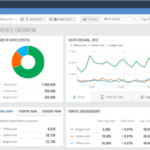Click here to buy secure, speedy, and reliable Web hosting, Cloud hosting, Agency hosting, VPS hosting, Website builder, Business email, Reach email marketing at 20% discount from our Gold Partner Hostinger You can also read 12 Top Reasons to Choose Hostinger’s Best Web Hosting
Looking for chrome extensions keyword research free that actually surface long-tail ideas while you browse? I use a small set of extensions that turn Google results, pages and SERP features into a fast long-tail workflow. Below are ten Free Chrome Extensions That Find Long-Tail Keywords on which I mostly rely on, why each matters for long-tail discovery, quick tips for use, and which one I open first when I’m hunting phrases.
Enter Semrush One: a single product that combines keyword-level SEO metrics and new AI-search signals so teams can measure and act on total visibility across search engines and LLMs.
You can test these in real searches, and I checked their current descriptions and docs while writing.

Quick snapshot — my top picks of free Chrome extensions that find Long-Tail keywords
If you want a single recommendation: Keyword Surfer is the easiest way to spot long tails straight in Google results. If you want “more data” and cross-site insights, add Keywords Everywhere (freemium) and Ubersuggest. For page-level ideas, Wordtracker Scout and SEO Minion are handy.
Boost Your Rankings with Top 10 Free SEO Tools
1 — Keyword Surfer (free)
What it does: shows search volume, related keywords and on-page metrics directly in Google results.
Why it helps long-tail research: the related keywords panel surfaces multi-word suggestions you can build headlines from. It’s free and unobtrusive.
Quick tip: run your seed term and scan the “keyword ideas” list on the right — export the promising phrases to a spreadsheet.
7 Best Free Keyword Research Tools for SEO and Website Ranking
2 — Keywords Everywhere (freemium)
What it does: displays monthly volumes and CPC in SERPs and other sites; has extra paid features but useful free bits.
Why it helps: it overlays volume data where you search, making many long tails obvious without switching tabs.
Quick tip: use the free features for quick pruning; buy credits only when you need lots of exact volumes.
Free SEO Snippet & FAQ Schema Generator
3 — Ubersuggest (Neil Patel) extension
What it does: shows volume, CPC and difficulty in SERPs and on YouTube/Amazon searches.
Why it helps: it pulls related phrase ideas and competitor pages into view as you browse. Great for spotting low-competition long phrases.
Quick tip: use it on Amazon or YouTube to find purchase-intent or how-to long tails.
What are White Label Guest Posts – A Practical Guide for Agencies and SEOs
4 — MozBar
What it does: instant page/domain metrics (DA/PA, links) and on-page element inspection.
Why it helps: you can quickly judge whether a long-tail SERP is winnable by checking authority of ranking pages. If many results have low DA, that long tail is worth a shot.
Quick tip: open MozBar, run your long-tail query, and scan top results for weak pages you can beat.
Semrush One Helps Track SEO and AI Visibility in One Place
5 — SEO Minion
What it does: on-page checks, SERP preview and a “scrape People Also Ask” feature.
Why it helps: it extracts PAA questions that are naturally long-tail queries — perfect for FAQ sections and subheads.
Quick tip: use its PAA scraper on target SERPs and drop the questions into your post’s FAQ block.
6 — Wordtracker Scout
What it does: inspects any page and extracts keyword clouds and high-value phrases.
Why it helps: great when you browse competitor pages and want to steal long-tail angle ideas they’re using.
Quick tip: visit a niche blog, open Scout, and export the keyword cloud as starter ideas.
SerpRobot Review: 9 Expert Tips to Boost Your SEO Rankings
7 — People Also Ask extractor
What it does: scrapes and normalises People Also Ask (PAA) snippets from Google.
Why it helps: PAA is a goldmine of question-style long tails you can answer directly. Use this to gather intent clusters.
Quick tip: filter duplicates and rephrase questions into headings that match search intent.
8 — AlsoAsked (bookmarklet/workflow)
What it does: visual map of PAA relationships (site also has a web tool).
Why it helps: it shows how questions branch out — great for building a content cluster around a seed long tail.
Quick tip: run AlsoAsked on a seed keyword and pick deep nodes as long-tail ideas.
9 — Keyword Surfer’s “related pages” & SERP exports (bonus use)
What it does: small export features and overlap scores.
Why it helps: the overlap score shows which long tails competitor pages already cover; use lower overlap for easier wins.
Quick tip: export 20 related terms and sort them by word count — 4+ word queries tend to be true long tails.
10 Best Semrush Alternatives and Why They’re Worth Considering
10 — Page-level inspectors & snippet helpers (combination)
Extensions like SEO Minion, MozBar and Wordtracker Scout together give you page lists, headings, and phrase clouds — the combo shows which long tails are answered poorly on the page, and where you can add value. Use them as a group rather than singly.
Quick tip: run a seed query, collect PAAs, related keywords and page headings, then write a draft that answers the full question set — that’s how you capture long-tail clicks.
7 Best Free Keyword Research Tools for SEO and Website Ranking
How You can test these extensions
You can run the same seed queries across Google, YouTube and Amazon, then compare: (a) related keyword suggestions; (b) PAA questions; (c) page authority of top results. You can also test the export flow. Keyword Surfer and Ubersuggest can cut you discovery time the most; MozBar and SEO Minion will help you decide which long tails are realistic targets.
13 Best Ahrefs Alternatives to Supercharge Your SEO
Quick workflow you can copy (5 minutes)
Run seed term in Google with Keyword Surfer on.
Save 10 related phrases with 3+ words.
Run People Also Ask extractor and add 5 question-style long tails.
Check top results with MozBar — pick long tails where top pages have low DA.
Draft a short post answering the PAA questions and include the long tails in H2s.
5 SEO Problems Killing Your Traffic (and How the SEMrush 7-Day Trial Fixes Them)
FAQ
Q: Are these extensions really free?
A: Most listed extensions offer free features; some (Keywords Everywhere, Ubersuggest) also have paid or freemium tiers for extra data. Always check the extension page and official docs.
Q: Which extension finds the best long-tail ideas quickly?
A: I start with Keyword Surfer for quick ideas and then use PAA scrapers (SEO Minion / People Also Ask extractor) to convert questions into long tails.
Q: Will these tools show exact search volume?
A: Free versions often show estimates. For exact, large-scale volume you’ll need a paid provider or Google Keyword Planner. Keywords Everywhere gives quick volume overlays but uses a freemium credit model.
Now loading...






